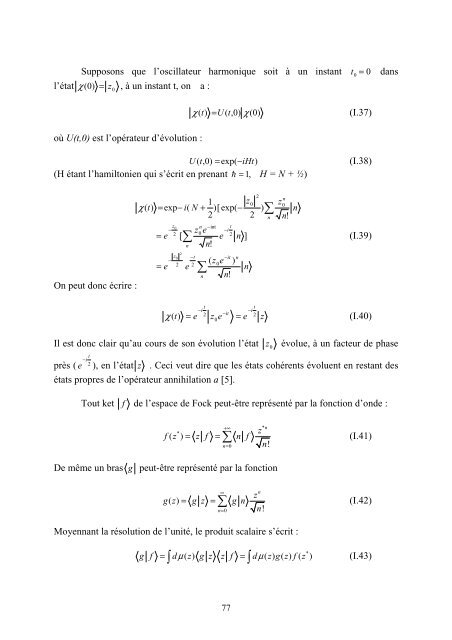Annexe IV Modèle de Hubbard standard et états cohérents - Toubkal
Annexe IV Modèle de Hubbard standard et états cohérents - Toubkal
Annexe IV Modèle de Hubbard standard et états cohérents - Toubkal
Create successful ePaper yourself
Turn your PDF publications into a flip-book with our unique Google optimized e-Paper software.
Supposons que l’oscillateur harmonique soit à un instant t0= 0 dansl’état χ ( 0) = z0, à un instant t, on a :où U(t,0) est l’opérateur d’évolution :χ( t ) = U ( t,0)χ(0)(I.37)U ( t,0)= exp( −iHt)(I.38)(H étant l’hamiltonien qui s’écrit en prenant h = 1,H = N + ½)1 z0χ(t)= exp−i(N + )[exp( −2 2= ez0−2[∑nzn0e−intn!<strong>et</strong>−i2n ]2)∑nzn0n!n(I.39)On peut donc écrire := e2z0−2e−t2∑n( z0e−itn!)nnt−it−i2 −it2χ ( t)= e z e = e z(I.40)0Il est donc clair qu’au cours <strong>de</strong> son évolution l’état z0évolue, à un facteur <strong>de</strong> phas<strong>et</strong>i2près ( ), en l’état z . Ceci veut dire que les états cohérents évoluent en restant <strong>de</strong>se −états propres <strong>de</strong> l’opérateur annihilation a [5].Tout k<strong>et</strong> f <strong>de</strong> l’espace <strong>de</strong> Fock peut-être représenté par la fonction d’on<strong>de</strong> :* nz= = ∑ (I.41)n!+∞*f ( z ) z f n fn=0De même un bras g peut-être représenté par la fonction∞nzg( z)= g z = ∑ g n(I.42)n!n=0Moyennant la résolution <strong>de</strong> l’unité, le produit scalaire s’écrit :*∫ µ ( ) ∫ µ ( ) ( ) ( ) (I.43)g f = d z g z z f = d z g z f z77
















